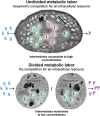Engineering microbial consortia for controllable outputs
- PMID: 26967105
- PMCID: PMC4989317
- DOI: 10.1038/ismej.2016.26
Engineering microbial consortia for controllable outputs
Abstract
Much research has been invested into engineering microorganisms to perform desired biotransformations; nonetheless, these efforts frequently fall short of expected results due to the unforeseen effects of biofeedback regulation and functional incompatibility. In nature, metabolic function is compartmentalized into diverse organisms assembled into robust consortia, in which the division of labor is thought to lead to increased community efficiency and productivity. Here we consider whether and how consortia can be designed to perform bioprocesses of interest beyond the metabolic flexibility limitations of a single organism. Advances in post-genomic analysis of microbial consortia and application of high-resolution global measurements now offer the promise of systems-level understanding of how microbial consortia adapt to changes in environmental variables and inputs of carbon and energy. We argue that, when combined with appropriate modeling frameworks, systems-level knowledge can markedly improve our ability to predict the fate and functioning of consortia. Here we articulate our collective perspective on the current and future state of microbial community engineering and control while placing specific emphasis on ecological principles that promote control over community function and emergent properties.
Figures



Similar articles
-
Mixed consortia in bioprocesses: role of microbial interactions.Appl Microbiol Biotechnol. 2016 May;100(10):4283-95. doi: 10.1007/s00253-016-7448-1. Epub 2016 Apr 2. Appl Microbiol Biotechnol. 2016. PMID: 27037693 Review.
-
Better together: engineering and application of microbial symbioses.Curr Opin Biotechnol. 2015 Dec;36:40-9. doi: 10.1016/j.copbio.2015.08.008. Epub 2015 Aug 28. Curr Opin Biotechnol. 2015. PMID: 26319893 Review.
-
Engineering of ecological niches to create stable artificial consortia for complex biotransformations.Curr Opin Biotechnol. 2020 Apr;62:129-136. doi: 10.1016/j.copbio.2019.09.008. Epub 2019 Oct 29. Curr Opin Biotechnol. 2020. PMID: 31671322 Review.
-
Global epistasis and the emergence of function in microbial consortia.Cell. 2024 Jun 6;187(12):3108-3119.e30. doi: 10.1016/j.cell.2024.04.016. Epub 2024 May 21. Cell. 2024. PMID: 38776921
-
Engineering microbial consortia by division of labor.Microb Cell Fact. 2019 Feb 8;18(1):35. doi: 10.1186/s12934-019-1083-3. Microb Cell Fact. 2019. PMID: 30736778 Free PMC article. Review.
Cited by
-
Plant Growth-Promoting Bacteria of Soil: Designing of Consortia Beneficial for Crop Production.Microorganisms. 2023 Nov 26;11(12):2864. doi: 10.3390/microorganisms11122864. Microorganisms. 2023. PMID: 38138008 Free PMC article. Review.
-
Natural Holobiome Engineering by Using Native Extreme Microbiome to Counteract the Climate Change Effects.Front Bioeng Biotechnol. 2020 Jun 4;8:568. doi: 10.3389/fbioe.2020.00568. eCollection 2020. Front Bioeng Biotechnol. 2020. PMID: 32582678 Free PMC article. Review.
-
Ecological landscapes guide the assembly of optimal microbial communities.PLoS Comput Biol. 2023 Jan 10;19(1):e1010570. doi: 10.1371/journal.pcbi.1010570. eCollection 2023 Jan. PLoS Comput Biol. 2023. PMID: 36626403 Free PMC article.
-
Microbial mutualism dynamics governed by dose-dependent toxicity of cross-fed nutrients.ISME J. 2017 Feb;11(2):337-348. doi: 10.1038/ismej.2016.141. Epub 2016 Nov 29. ISME J. 2017. PMID: 27898053 Free PMC article.
-
Recipient-Biased Competition for an Intracellularly Generated Cross-Fed Nutrient Is Required for Coexistence of Microbial Mutualists.mBio. 2017 Nov 28;8(6):e01620-17. doi: 10.1128/mBio.01620-17. mBio. 2017. PMID: 29184014 Free PMC article.
References
-
- Almeida JS, Reis MA, Carrondo MJ. (1995). Competition between nitrate and nitrite reduction in denitrification by Pseudomonas fluorescens. Biotechnol Bioeng 46: 476–484. - PubMed
-
- Bayer TS, Widmaier DM, Temme K, Mirsky EA, Santi DV, Voigt CA. (2009). Synthesis of methyl halides from biomass using engineered microbes. J Am Chem Soc 131: 6508–6515. - PubMed
-
- Becker GS, Murphy KM. (1994) Human Capital: A Theoretical and Empirical Analysis with Special Reference to Education. 3rd edn. The University of Chicago Press: Chicago, London, pp 299–322.
MeSH terms
LinkOut - more resources
Full Text Sources
Other Literature Sources

